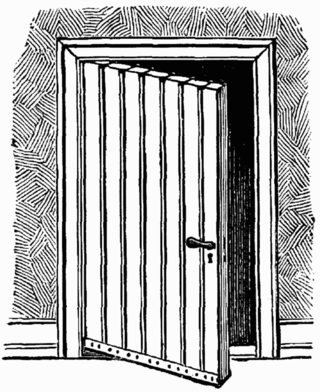
A door is a hinged or otherwise movable barrier that allows ingress (entry) into and egress (exit) from an enclosure. The created opening in the wall is a doorway or portal. A door's essential and primary purpose is to provide security by controlling access to the doorway (portal). Conventionally, it is a panel that fits into the doorway of a building, room, or vehicle. Doors are generally made of a material suited to the door's task. They are commonly attached by hinges, but can move by other means, such as slides or counterbalancing.

Traffic signs or road signs are signs erected at the side of or above roads to give instructions or provide information to road users. The earliest signs were simple wooden or stone milestones. Later, signs with directional arms were introduced, for example the fingerposts in the United Kingdom and their wooden counterparts in Saxony.

A shed is typically a simple, single-story roofed structure, often used for storage, for hobbies, or as a workshop, and typically serving as outbuilding, such as in a back garden or on an allotment. Sheds vary considerably in their size and complexity of construction, from simple open-sided ones designed to cover bicycles or garden items to large wood-framed structures with shingled roofs, windows, and electrical outlets. Sheds used on farms or in the industry can be large structures. The main types of shed construction are metal sheathing over a metal frame, plastic sheathing and frame, all-wood construction, and vinyl-sided sheds built over a wooden frame. Small sheds may include a wooden or plastic floor, while more permanent ones may be built on a concrete pad or foundation. Sheds may be lockable to deter theft or entry by children, domestic animals, wildlife, etc.

Upholstery is the work of providing furniture, especially seats, with padding, springs, webbing, and fabric or leather covers. The word also refers to the materials used to upholster something.

A window blind is a type of window covering. There are many different kinds of window blinds which use a variety of control systems. A typical window blind is made up of several long horizontal or vertical slats of various types of hard material, including wood, plastic or metal which are held together by cords that run through the blind slats. Vertical blinds run along a track system which can tilt open and closed and move side-to-side. Window blinds can be manoeuvred with either a manual or remote control by rotating them from an open position, with slats spaced out, to a closed position where slats overlap and block out most of the light. There are also several types of window coverings, called shades, that use a single piece of soft material instead of slats.

Traffic cones, also called pylons, witches' hats, road cones, highway cones, safety cones, caution cones, channelizing devices, construction cones, roadworks cones, or just cones, are usually cone-shaped markers that are placed on roads or footpaths to temporarily redirect traffic in a safe manner. They are often used to create separation or merge lanes during road construction projects or automobile accidents, although heavier, more permanent markers or signs are used if the diversion is to stay in place for a long period of time.
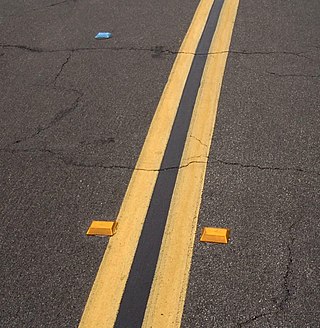
A raised pavement marker is a safety device used on roads. These devices are usually made with plastic, ceramic, thermoplastic paint, glass or occasionally metal, and come in a variety of shapes and colors. Raised reflective markers, such as plastic, ceramic, or metal ones, include a lens or sheeting that enhances their visibility by retroreflecting automotive headlights, while glass road studs gather automotive headlights with a dome shape and reflect the lights with a reflective layer within. Some other names for specific types of raised pavement markers include convex vibration lines, Botts' dots, delineators, cat's eyes, road studs, or road turtles. Sometimes they are simply referred to as "reflectors".

A bollard is a sturdy, short, vertical post. The term originally referred to a post on a ship or quay used principally for mooring boats. It now also refers to posts installed to control road traffic and posts designed to prevent automotive vehicles from colliding or crashing into pedestrians and structures.
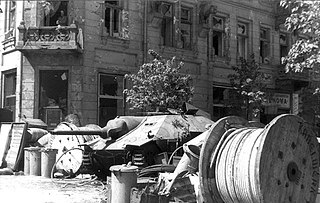
Barricade is any object or structure that creates a barrier or obstacle to control, block passage or force the flow of traffic in the desired direction. Adopted as a military term, a barricade denotes any improvised field fortification, such as on city streets during urban warfare.

In woodworking, a saw-horse or sawhorse is a trestle structure used to support a board or plank for sawing. A pair of sawhorses can support a plank, forming a scaffold. In certain circles, it is also known as a mule and a short sawhorse is known as a pony. The names come from the shape of the frame, which resembles a horse. A sawhorse may also be a rack for supporting logs for sawing, known in the US as a sawbuck.

A sandwich board is a type of advertisement tool composed of two boards with a message or graphic on it and being either carried by a person, with one board in front and one behind in a triangle shape, hinged along the top, creating a "sandwich" effect; or set up next to a store advertising its goods. In this way, the advertising message can be read on both sides interchangeably.
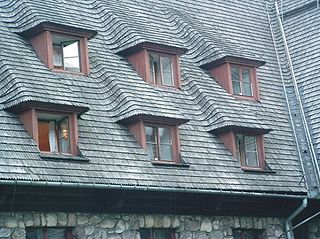
Roof shingles are a roof covering consisting of individual overlapping elements. These elements are typically flat, rectangular shapes laid in courses from the bottom edge of the roof up, with each successive course overlapping the joints below. Shingles are held by the roof rafters and are made of various materials such as wood, slate, flagstone, metal, plastic, and composite materials such as fibre cement and asphalt shingles. Ceramic roof tiles, which still dominate in Europe and some parts of Asia, are still usually called tiles. Roof shingles may deteriorate faster and need to repel more water than wall shingles. They are a very common roofing material in the United States.

Retroreflective sheeting is flexible retroreflective material primarily used to increase the nighttime conspicuity of traffic signs, high-visibility clothing, and other items so they are safely and effectively visible in the light of an approaching driver's headlamps. They are also used as a material to increase the scanning range of barcodes in factory settings. The sheeting consists of retroreflective glass beads, microprisms, or encapsulated lenses sealed onto a fabric or plastic substrate. Many different colors and degrees of reflection intensity are provided by numerous manufacturers for various applications. As with any retroreflector, sheeting glows brightly when there is a small angle between the observer's eye and the light source directed toward the sheeting but appears nonreflective when viewed from other directions.
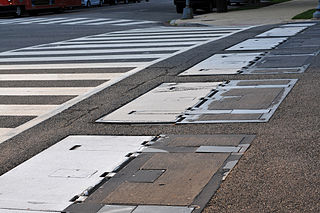
Barrier boards are typically long plastic or wooden beams or metal plates used during road works and similar activities to cordon off areas, close roads or direct traffic.

A bicycle parking rack, usually shortened to bike rack and also called a bicycle stand, is a device to which bicycles can be securely attached for parking purposes. It may be freestanding, or securely attached to the ground or a stationary object, such as a building. Indoor racks are commonly used for private bicycle parking, while outdoor racks are often used in commercial areas. General styles of racks include the Inverted U, Serpentine, Bollard, Grid, and Decorative. The most effective and secure bike racks are those that can secure both wheels and the frame of the bicycle, using a bicycle lock.

Construction barrels are traffic control devices used to channel motor vehicle traffic through construction sites or to warn motorists of construction activity near the roadway. They are used primarily in the United States, but are occasionally used in Canada, Mexico and Costa Rica. They are an alternative to traffic cones which are smaller and easily hit by vehicles. Drums tend to command more respect from drivers than cones as they are larger, more visible, and give the appearance of being formidable obstacles.
Road traffic control devices are markers, signs and signal devices used to inform, guide and control traffic, including pedestrians, motor vehicle drivers and bicyclists. These devices are usually placed adjacent, over or along the highways, roads, traffic facilities and other public areas that require traffic control.

Barricade tape is brightly colored tape that is used to warn or catch the attention of passersby of an area or situation containing a possible hazard. It acts as a minor impediment to prevent accidental entrance to that area or situation and as a result enhances general safety. Barricade tape is also known as construction tape or barrier tape, or in reference to the safety hazard involved as caution tape, warning tape, danger tape or hazard tape. When used by police, the tape is named police tape.
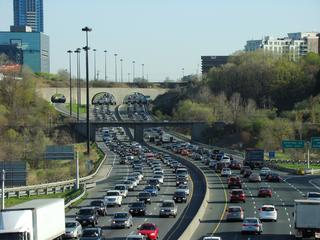
Terminology related to road transport—the transport of passengers or goods on paved routes between places—is diverse, with variation between dialects of English. There may also be regional differences within a single country, and some terms differ based on the side of the road traffic drives on. This glossary is an alphabetical listing of road transport terms.


















